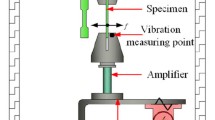Conclusions
Vibrational working (upsetting) produces a more uniform structure and hardness distribution within the reduced specimen than static loading. This is apparently the main reason for the better forming properties of metals in vibrational working. The strain hardening of the end surfaces of the vibrated specimens is less than that of those subjected to a static load [for the same reduction].
Similar content being viewed by others
Reference
L. I. Zhivov, Machines and Methods of Plastic Metalworking, Collected Papers from the Moscow (Bauman) Higher Technical College, Mashgiz, 1952.
Rights and permissions
About this article
Cite this article
Sogrishin, Y.P. Vibrational working of metal. Met Sci Heat Treat 1, 61–62 (1959). https://doi.org/10.1007/BF00807930
Issue Date:
DOI: https://doi.org/10.1007/BF00807930



